TEXAS FLOODS RAISE DOUBTS OVER US WEATHER WARNINGS, RESPONSE LEVELS
Fears voiced that federal budget cuts are having negative impact, as search for survivors continues

As the desperate search continues for survivors of the flash floods in Central Texas, concerns have already been raised about the shortcomings of the United States' weather warning service and the response of local authorities.
The death toll stood at 82 late on Sunday, with Texas Governor Greg Abbott saying that 41 people were unaccounted for across the state, adding that more people could be missing, local media reported.
In Kerr County, home to Camp Mystic and other youth camps in the Texas Hill Country, searchers have found the bodies of 68 people, including 28 children, said Sheriff Larry Leitha, who pledged to keep searching until "everybody is found".
The flash floods happened in a region where the natural beauty of rivers, lakes and hills has made it a popular destination for summer vacations. The Guadalupe River bank area had attracted many visitors for the long Fourth of July weekend.
However, before daybreak on Friday destructive, fast-moving waters rose rapidly on the river in only 45 minutes, washing away homes and vehicles.
Questions are growing about whether enough warnings were issued in an area long vulnerable to flooding and whether enough preparations were made.
Families were allowed to look around Camp Mystic, a Christian summer camp along the river where 10 girls and a counselor were still unaccounted for, on Sunday morning.
One girl was seen walking out of a building carrying a large bell. A woman and a teenage girl, both wearing rubber waders, briefly went inside one of the cabins, which stood next to a pile of soaked mattresses, a storage trunk and clothes. At one point, the pair doubled over, sobbing before they embraced.
Father's sacrifice
Several of those who died in the floods have already been praised by loved ones for their heroism.
Julian Ryan, 27, died trying to save his mother, his fiancee Christina Wilson, and the couple's two young children, according to local media reports.
Wilson told a Houston television station the water came to the front step of their trailer home near the river in Ingram before dawn on Friday and rose fast. Their mattress began to float. The door was stuck shut and Ryan broke a window with his arm for the family to escape. However, he suffered serious cuts from the broken glasses and soon bled to death.
"He had lost so much blood and knew he wasn't going to make it," Wilson said. "He said, 'I love you. I'm so sorry.' In minutes, he was gone. He died trying to save us."
Camp Mystic director Dick Eastland, 70, died while trying to rescue campers during the catastrophic flooding, according to a tribute shared by his grandson on Instagram on Saturday.
"If he wasn't going to die of natural causes, this was the only other way — saving the girls that he so loved and cared for," George Eastland wrote. "That's the kind of man my grandfather was. He was a husband, father, grandfather, and a mentor to thousands of young women."
A Camp Mystic employee, Glenn Juenke, told CNN Eastland died "remaining a true hero until the very end".
Almost a century old and founded in 1926, Camp Mystic had been run by Dick and Tweety Eastland since 1974 and can host up to 700 children.
In Kerrville, Tivy High School boys soccer coach Reece Zunker and his wife Paula died in the flood, according to a Facebook post. Their two young children were missing.
The Guadalupe River Heart O' the Hills Camp announced on its website that its director and co-owner Jane Ragsdale was killed in the flood. Luckily no children were at the camp at the time.
Two sisters from Dallas, Blair and Brooke Harber, 11 and 13 respectively, were staying with their grandparents in a cabin along the Guadalupe River, which was washed away by the flood. The sisters were confirmed dead and their grandparents were missing, according to The New York Times.
Too late, inaccurate
The National Weather Service first issued a forecast on Thursday afternoon that heavy rain was coming and flooding was possible. It predicted 127 to 177 millimeters of rain.
The flood warning was issued at 1:14 am on Friday when most people were asleep. It triggered Wireless Emergency Alerts which sent notifications to all the mobile phones in the emergency area.
However, it's a feature that mobile phone users can disable and parts of the Hill Country lack good mobile phone reception.
The rain began to fall around midnight, but actual rainfall far exceeded the forecast. Some local weather stations recorded 305 mm of rainfall by sunrise on Independence Day, local meteorologists said.
The water level rose rapidly. The water gauge in a section of the Guadalupe River gauge where it forks recorded a 6.7-meter rise in only two hours, Bob Fogarty, a meteorologist at the NWS Austin/San Antonio office said.
In Kerrville, the water level rose from 0.3 meters to 10.3 meters between 2 am and 7 am on Friday.
Fogarty said the alert was updated nine times throughout Friday. The most serious warning came at 4:03 am when NWS issued a flood emergency, warning of an "extremely dangerous and life-threatening situation "and urging "immediate evacuations".
The riverbank overflow occurred about three hours after the first flood warning, with the strong torrent washing away cabins and vehicles.
Some meteorologists said local authorities are partially responsible for the devastating consequences of the floods.
"The heartbreaking catastrophe that occurred in Central Texas is a tragedy of the worst sort because it appears evacuations and other proactive measures could have been undertaken to reduce the risk of fatalities had the organizers of impacted camps and local officials heeded the warnings of the government and private weather sources, including AccuWeather," AccuWeather chief meteorologist Jonathan Porter wrote in a statement on Saturday morning.
Local officials blamed the NWS for inadequate weather information. Nim Kidd, chief of the Texas Division of Emergency Management pointed to NWS forecasts that projected up to 152 mm of rain. "It did not predict the amount of rain that we saw," Kidd said.
Facing questions on why officials didn't organize evacuations, Kerr County Judge Rob Kelly said: "We didn't know this flooding was coming. Rest assured, no one knew this kind of flood was coming."
Kelly said they deal with floods frequently and locals know the area as "flash flood valley". However, Kerr County doesn't have a flood warning system in place. Kelly said the county considered implementing one a few years ago, but the plan was put aside due to the cost.
Kerrville City Manager Dalton Rice told the media that the suddenness and intensity of the flood caught city officials flat-footed.
"This happened very quickly over a very short amount of time that could not be predicted," Rice said,"… things like this happen in a very strategic, very isolated area and when those two things converge you have what happened today."
Staff shortage at NWS
The unexpectedness of the flood has led many to question whether the understaffed NWS has contributed to the tragedy.
Its ability to help the entire country prepare for natural disasters was also questioned due to funding cuts under the Trump administration's Big Beautiful Bill which was passed the day before July 4.
Federal funding cuts made earlier by the Department of Government Efficiency led to staff cuts in the NWS, which the service says has resulted in many of its local offices being understaffed.
Its mission statement is to: "Provide weather, water and climate data, forecasts, warnings, and impact-based decision support services for the protection of life and property and enhancement of the national economy."
Accurate weather warnings are the key to "give every individual a fighting chance to survive nature's worst", it adds.
Since President Donald Trump took office, almost 600 people have left the NWS, equivalent to the total number of employees who left the service in the past 15 years.
Many of those who left were seasoned meteorologists with experience in dealing with a variety of weather scenarios. Experts had previously warned that the service had already been crippled due to its large number of vacant positions and sudden departure of senior staff.
The NWS Austin/San Antonio Office, which oversees flood-devastated Kerr County, is currently short six staff members. A senior hydrologist, staff forecaster and meteorologist in charge were missing, according to the NWS website.
While no one at the NWS has explained the big gap between the forecast and actual rainfall, Homeland Security Secretary Kristi Noem defended the administration, saying that it's hard to accurately predict rainfall.
Noem argued that the technology was "ancient" and that the Trump administration is working to upgrade it.
"We know that everybody wants more warning time, and that's why we're working to upgrade the technologies that have been neglected (for) far too long," Noem said at a Saturday news conference.
Houston has a problem
Jason Walls, a Houston resident, told China Daily the tragedy unfolding in Central Texas had made him worried about his own safety in Houston.
"We are in the hurricane season right now. I can't imagine how many people would die from an inaccurate weather forecast and inadequate warning because we are much more populated than Central Texas. I am very concerned," Walls said.
He's aware that the NWS Houston/Galveston Office has a serious staff shortage with 11 positions out of 25 vacant. The departures happened after a number of experienced meteorologists left due to the DOGE cuts.
The vacancies include meteorologist-incharge, warning coordination meteorologist, science and operations officer, and port meteorological officer. In addition, four meteorologists, including two senior positions, are also vacant.
Meteorologist Jeff Masters, a former National Oceanic and Atmospheric Administration hurricane hunter, earlier told the Texas Tribune that most of the roles won't be able to be filled in time for the 2025 hurricane season.
"This was done very inefficiently," Masters told the newspaper. "First, all of the probationary employees were fired, then incentives were given to get the most experienced managers out through early retirement. Now they're trying to do some rehiring, and then it's just not being done very efficiently."
Masters said that the local offices across the country have lost critical institutional knowledge and expertise. Nationwide, reduced staff numbers have meant fewer weather balloon launches, therefore fewer data critical to accurate storm modeling is available.
Currently, the Houston office is being helped by members from other NWS locations, and a meteorologist in Oklahoma is helping as an acting meteorologist-incharge for Houston.
"Look at what happened in Kerr County when the NWS local office is without a warning coordination meteorologist," Walls said. "We are in a worse situation in Houston — we don't have a warning coordinator, we don't have one in charge, we are missing almost half of very critical positions. How can we be ready for any weather disaster in the coming months?"
Agencies contributed to this story.
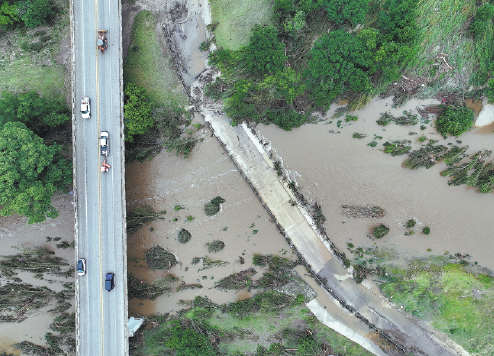
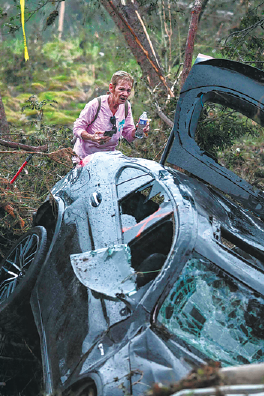

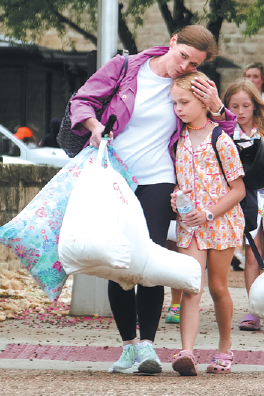
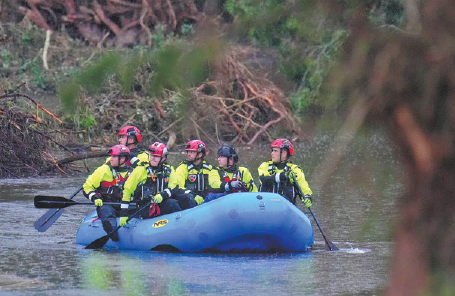
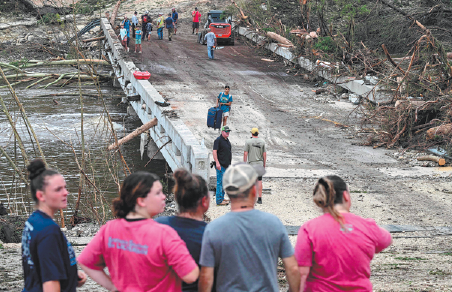
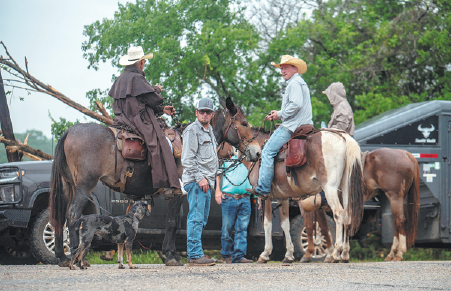
Today's Top News
- China remembers victims of Nanjing Massacre, 88 years on
- New plan will be a road map for a stronger future
- Taiwan's character of the year a vote against confrontation
- Strengthened resilience key for economy
- Video sheds new light on Japan's wartime atrocities
- Xi: World yearns for peace, trust more than ever






























